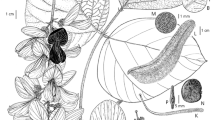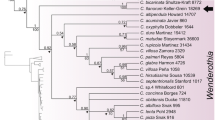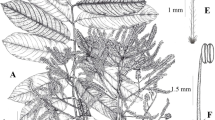Abstract
Ormosia timboënsis is described and illustrated as a new species based on fruit and leaf material collected in a fragment of Atlantic Rain Forest in central Bahia State, Brazil. This new species can be recognized by possessing the largest seed and hilum of those that have been reported in Ormosia. In addition, O. timboënsis has leaves that in combination with the fruit characters do not match any species currently described in the genus.
Resumo
Ormosia timboënsis é descrita e ilustrada como nova espécie baseada apenas em material com folha e fruto coletado em um fragmento de Floresta Atlântica ombrófila na região central da Bahia, Brasil. Esta nova espécie pode ser diferenciada por possuir semente e hilo dentre os maiores já vistos em Ormosia. Além disso, O. timboënsis apresenta folhas que em combinação com os caracteres do fruto não permitem acomodá-la em nenhuma das espécies atualmente descritas no gênero.


Similar content being viewed by others
Literature Cited
Bentham, G. 1862. Leguminosae. Pp. 270–271. In: C. F. P. von Martius, A. W. Eichler & I. Urban (eds.), Flora Brasiliensis, Monachii, Lipsiae, Frid. Fleischer in comm. Vol. 15, part 1.
Doyle, J. J., J. A. Chappill, C. D. Bailey & T. Kajita. 2000. Towards a comprehensive phylogeny of legumes: evidence from rbcL sequences and non-molecular data. Pp. 1–20. In: P. S. Herendeen & A. Bruneau (eds.), Advances in legume systematics, part 9. Royal Botanic Gardens, Kew.
Ducke, A. 1939. As espécies brasileiras do gênero Ormosia Jacks. (“tento”, “tenteiro”, “olho de cabra”, “olho de boi”, “buiussú”). Annaes da Academia Brasileira de Sciencias 11(3): 179–195.
International Union for Conservation of Nature and Natural Resources (IUCN). 2001. IUCN Red List Categories and Criteria, Version 3.1. IUCN, Gland, Switzerland and Cambridge, United Kingdom. http://www.iucn.org.
Käss, E. & M. Wink. 1997. Phylogenetic relationships in the Papilionoideae (Leguminosae) based on nucleotide sequences of cpDNA (rbcL) and ncDNA (ITS 1 and 2). Molecular Phylogenetics and Evolution 8: 65–88.
Lavin, M., P. Herendeen & M. F. Wojciechowski. 2005. Evolutionary rates analysis of Leguminosae implicates a rapid diversification of lineages during the Tertiary. Systematic Biology 54(4): 530–549.
Martini, A. M. Z., P. Fiaschi, A. M. Amorim & J. L. da Paixão. 2007. A hot-point within a hot-spot: a high diversity site in Brazil’s Atlantic Forest. Biodiversity and Conservation 16: 3111–3128.
Pennington, R. T., C. H. Stirton & B. D. Schrire. 2005. Tribe Sophoreae. Pp. 227–249. In: G. P. Lewis, B. D. Schrire, B. A. Mackinder & M. Lock (eds.), Legumes of the world. Royal Botanic Gardens, Kew.
———, M. Lavin, H. Ireland, B. Klitgaard, J. Preston & J.-M. Hu. 2001. Phylogenetic relationships of basal papilionoid legumes based upon sequences of the chloroplast trnL intron. Systematic Botany 26: 537–556.
———, B. B. Klitgaard, H. Ireland & M. Lavin. 2000. New insights into floral evolution of basal Papilionoideae from molecular phylogenies. Pp. 233–248. In: P. S. Herendeen & A. Bruneau (eds.), Advances in Legume Systematics, part 9. Royal Botanic Gardens, Kew.
Polhill, R. M. 1981. Tribe Sophoreae. Pp. 213–230. In: R. M. Polhill & P. H. Raven (eds.), Advances in legume systematics, part 1. Royal Botanic Gardens, Kew.
Rudd, V. E. 1965. The American species of Ormosia (Leguminosae). Contributions from the United States National Herbarium 32(5): 279–384.
Thomas, W. W., J. G. Jardim, P. Fiaschi & A. M. Amorim. 2003. Lista preliminar de angiospermas endêmicas do sul da Bahia e norte do Espírito Santo, Brasil. In: P. I. Prado, E. C. Landau, R. T. Moura, L. P. S. Pinto, G. A. B. Fonseca & K. Alger (orgs.), Corredor de Biodiversidade da Mata Atlântica do Sul da Bahia. Published in CD-ROOM. IESB/CI/CABS/UFMG/UNICAMP, Ilhéus.
———, A. M. V. Carvalho, A. M. Amorim, J. Garrison & A. L. Arbeláez. 1998. Plant endemism in two forests in southern Bahia, Brazil. Biodiversity and Conservation 7: 311–322.
Wojciechowski, M. F. , M. Lavin & M. J. Sanderson. 2004. A phylogeny of legumes (Leguminosae) based on analysis of the plastid matK gene resolves many well-supported subclades within the family. American Journal of Botany 91: 1846–1862.
Yakovlev, G. P. 1972. De tribu Sophoreae Spreng. Fabacearum notulae systematicae, 1. Genera Bolusanthus Harms, Diplotropis Benth., Trichocyamos Yakovlev et Bowdichia Kunth. Novosti Sistematiki Vysshikh Rastenii 9: 197–203.
———. 1971. A contribution to the revision of the genus Ormosia Jacks.: 1. The genera Ruddia Yakovl. and Fedorovia Yakovl. (Leguminosae). Botanicheskii Zhurnal 56: 652–658.
Acknowledgments
Thanks are due to Dr. Luciano Paganucci de Queiroz for writing the Latin diagnosis and numerous suggestions that greatly improved the manuscript; Carla de Lima for the beautiful drawing; Márcia Neves, José Lima, Josival Souza, and Sr. Manoel for the assistance in the field work; and Centro Sapucaia and Projeto Timbó MMA/PDA for providing financial support during field work. The critical comments by Dr. Ana Maria Goulart de Azevedo Tozzi and an anonymous referee are gratefully acknowledged. This paper is part of the MSc. thesis of DBOSC prepared in the Programa de Pós-graduação em Botânica (PPGBot-UEFS) and supported by a grant from CNPq (Process 131147/2007-2).
Author information
Authors and Affiliations
Corresponding author
Rights and permissions
About this article
Cite this article
Cardoso, D.B.O.S., Meireles, J.E. & de Lima, H. A remarkable new species of Ormosia (Leguminosae: Papilionoideae: Sophoreae) from Bahian Atlantic Rain Forest, Brazil. Brittonia 61, 22–27 (2009). https://doi.org/10.1007/s12228-008-9051-y
Published:
Issue Date:
DOI: https://doi.org/10.1007/s12228-008-9051-y




